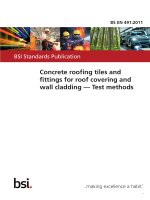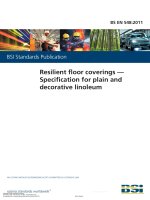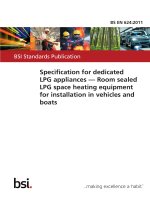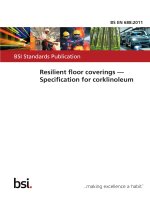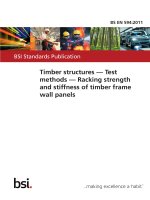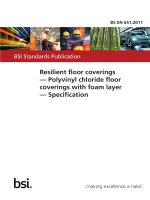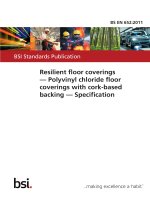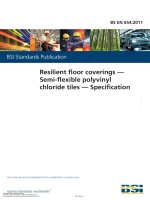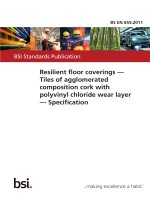Bsi bs en 62208 2011
Bạn đang xem bản rút gọn của tài liệu. Xem và tải ngay bản đầy đủ của tài liệu tại đây (1.11 MB, 26 trang )
BS EN 62208:2011
BSI Standards Publication
Empty enclosures for
low-voltage switchgear
and controlgear assemblies —
General requirements
BRITISH STANDARD
BS EN 62208:2011
National foreword
This British Standard is the UK implementation of EN 62208:2011. It is identical to IEC 62208:2011. It supersedes BS EN 62208:2003, which will be withdrawn on 23 September 2014.
The UK participation in its preparation was entrusted by Technical Committee
PEL/17, Switchgear, controlgear, and HV-LV co-ordination, to Subcommittee
PEL/17/3, Low voltage switchgear and controlgear assemblies.
A list of organizations represented on this committee can be obtained on
request to its secretary.
This publication does not purport to include all the necessary provisions of a
contract. Users are responsible for its correct application.
© BSI 2011
ISBN 978 0 580 65631 6
ICS 29.130.20
Compliance with a British Standard cannot confer immunity from
legal obligations.
This British Standard was published under the authority of the Standards
Policy and Strategy Committee on 30 November 2011.
Amendments issued since publication
Amd. No.
Date
Text affected
BS EN 62208:2011
EUROPEAN STANDARD
EN 62208
NORME EUROPÉENNE
EUROPÄISCHE NORM
October 2011
ICS 29.130.20
Supersedes EN 62208:2003
English version
Empty enclosures for low-voltage switchgear
and controlgear assemblies General requirements
(IEC 62208:2011)
Enveloppes vides destinées aux
ensembles d'appareillage
à basse tension Exigences générales
(CEI 62208:2011)
Leergehäuse für NiederspannungsSchaltgerätekombinationen Allgemeine Anforderungen
(IEC 62208:2011)
This European Standard was approved by CENELEC on 2011-09-23. CENELEC members are bound to comply
with the CEN/CENELEC Internal Regulations which stipulate the conditions for giving this European Standard
the status of a national standard without any alteration.
Up-to-date lists and bibliographical references concerning such national standards may be obtained on
application to the CEN-CENELEC Management Centre or to any CENELEC member.
This European Standard exists in three official versions (English, French, German). A version in any other
language made by translation under the responsibility of a CENELEC member into its own language and notified
to the CEN-CENELEC Management Centre has the same status as the official versions.
CENELEC members are the national electrotechnical committees of Austria, Belgium, Bulgaria, Croatia, Cyprus,
the Czech Republic, Denmark, Estonia, Finland, France, Germany, Greece, Hungary, Iceland, Ireland, Italy,
Latvia, Lithuania, Luxembourg, Malta, the Netherlands, Norway, Poland, Portugal, Romania, Slovakia, Slovenia,
Spain, Sweden, Switzerland and the United Kingdom.
CENELEC
European Committee for Electrotechnical Standardization
Comité Européen de Normalisation Electrotechnique
Europäisches Komitee für Elektrotechnische Normung
Management Centre: Avenue Marnix 17, B - 1000 Brussels
© 2011 CENELEC -
All rights of exploitation in any form and by any means reserved worldwide for CENELEC members.
Ref. No. EN 62208:2011 E
BS EN 62208:2011
EN 62208:2011
-2-
Foreword
The text of document 17D/442/FDIS, future edition 2 of IEC 62208, prepared by SC 17D, "Low-voltage
switchgear and controlgear assemblies", of IEC TC 17, "Switchgear and controlgear" was submitted to
the IEC-CENELEC parallel vote and approved by CENELEC as EN 62208:2011.
The following dates are fixed:
•
•
latest date by which the document has
to be implemented at national level by
publication of an identical national
standard or by endorsement
latest date by which the national
standards conflicting with the
document have to be withdrawn
(dop)
2012-06-23
(dow)
2014-09-23
This document supersedes EN 62208:2003.
EN 62208:2011 constitutes a technical revision and includes the following significant technical changes
with respect to EN 62208:2003:
– consideration of the restructured series of standards EN 61439;
– alignment of test procedures with the newest relevant standards.
Attention is drawn to the possibility that some of the elements of this document may be the subject of
patent rights. CENELEC [and/or CEN] shall not be held responsible for identifying any or all such patent
rights.
Endorsement notice
The text of the International Standard IEC 62208:2011 was approved by CENELEC as a European
Standard without any modification.
In the official version, for Bibliography, the following notes have to be added for the standards indicated:
IEC 60216 series
NOTE Harmonized in EN 60216 series.
IEC 60670 series
NOTE Harmonized in EN 60670 series.
IEC/TR 60890
NOTE Harmonized as CLC/TR 60890.
IEC 61000-5-7:2001
NOTE Harmonized as EN 61000-5-7:2001 (not modified).
IEC 61439 series
NOTE Harmonized in EN 61439 series.
BS EN 62208:2011
EN 62208:2011
-3-
Annex ZA
(normative)
Normative references to international publications
with their corresponding European publications
The following referenced documents are indispensable for the application of this document. For dated
references, only the edition cited applies. For undated references, the latest edition of the referenced
document (including any amendments) applies.
NOTE When an international publication has been modified by common modifications, indicated by (mod), the relevant EN/HD
applies.
Publication
Year
Title
EN/HD
Year
IEC 60068-2-2
2007
Environmental testing Part 2-2: Tests - Test B: Dry heat
EN 60068-2-2
2007
IEC 60068-2-11
1981
Environmental testing Part 2: Tests - Test Ka: Salt mist
EN 60068-2-11
1999
IEC 60068-2-30
2005
Environmental testing EN 60068-2-30
Part 2-30: Tests - Test Db: Damp heat, cyclic
(12 h + 12 h cycle)
2005
IEC 60085
2007
Electrical insulation - Thermal evaluation and EN 60085
designation
2008
IEC 60529
1989
Degrees of protection provided by enclosures EN 60529
(IP Code)
+ corr. May
1991
1993
IEC 60695-2-10
2000
Fire hazard testing EN 60695-2-10
Part 2-10: Glowing/hot-wire based test
methods - Glow-wire apparatus and common
test procedure
2001
IEC 60695-2-11
2000
EN 60695-2-11
Fire hazard testing Part 2-11: Glowing/hot-wire based test
methods - Glow-wire flammability test method
for end-products
2001
IEC 61439-1
2011
Low-voltage switchgear and controlgear
assemblies Part 1: General rules
IEC 62262
2002
Degrees of protection provided by enclosures EN 62262
for electrical equipment against external
mechanical impacts (IK code)
2002
ISO 178
2001
Plastics - Determination of flexural properties EN ISO 178
2003
ISO 179
Series Plastics - Determination of Charpy impact
properties
EN ISO 179
Series
ISO 2409
2007
Paints and varnishes - Cross-cut test
EN ISO 2409
2007
ISO 4628-3
2003
Paints and varnishes - Evaluation of
degradation of coatings - Designation of
quantity and size of defects, and of intensity
of uniform changes in appearance Part 3: Assessment of degree of rusting
EN ISO 4628-3
2003
ISO 4892-2
+ A1
2006
2009
Plastics - Methods of exposure to laboratory
light sources Part 2: Xenon-arc lamps
EN ISO 4892-2
+ A1
2006
2009
ISO 11469
2000
Plastics - Generic identification and marking
of plastic products
EN ISO 11469
2000
EN 61439-1
2011
BS EN 62208:2011
–2–
62208 © IEC:2011
CONTENTS
1
Scope ............................................................................................................................... 6
2
Normative references ....................................................................................................... 6
3
Terms and definitions ....................................................................................................... 7
4
Classification .................................................................................................................... 8
5
EMC requirements ............................................................................................................ 8
6
Information to be given regarding the enclosure ............................................................... 9
6.1
6.2
6.3
7
General ................................................................................................................... 9
Marking ................................................................................................................... 9
Documentation ........................................................................................................ 9
6.3.1 General ....................................................................................................... 9
6.3.2 Dimensions ................................................................................................. 9
6.3.3 Mounting arrangements ............................................................................. 10
6.3.4 Permissible loads ...................................................................................... 10
6.3.5 Lifting and transport support ...................................................................... 10
6.3.6 Protective circuit ........................................................................................ 10
Service conditions .......................................................................................................... 10
7.1
7.2
8
General ................................................................................................................. 10
Normal service conditions ..................................................................................... 10
7.2.1 Ambient air temperature ............................................................................ 10
7.2.2 Humidity conditions ................................................................................... 11
7.3 Special service conditions ..................................................................................... 11
7.4 Conditions during transport and storage ................................................................ 11
Design and construction ................................................................................................. 11
9
8.1
8.2
8.3
8.4
8.5
8.6
8.7
8.8
Type
General ................................................................................................................. 11
Static loads ........................................................................................................... 12
Lifting and transport support .................................................................................. 12
Access to the interior of the enclosure ................................................................... 12
Protective circuit.................................................................................................... 12
Dielectric strength ................................................................................................. 12
Degree of protection (IK code) ............................................................................... 12
Degree of protection (IP code) ............................................................................... 13
tests ...................................................................................................................... 13
9.1
9.2
9.3
9.4
9.5
9.6
9.7
9.8
General ................................................................................................................. 13
General conditions of tests .................................................................................... 13
Marking ................................................................................................................. 14
Static loads ........................................................................................................... 14
Lifting .................................................................................................................... 14
Axial loads of metal inserts .................................................................................... 15
Degree of protection against external mechanical impacts (IK code) ..................... 15
Degree of protection (IP code) ............................................................................... 16
9.8.1 Degree of protection against access to hazardous parts and against
the ingress of solid foreign objects indicated by first characteristic
numeral ..................................................................................................... 16
9.8.2 Degree of protection against ingress of water as indicated by second
characteristic numeral ............................................................................... 16
BS EN 62208:2011
62208 © IEC:2011
–3–
9.8.3
Degree of protection against hazardous parts as indicated by
additional letter .......................................................................................... 17
9.9 Properties of insulating materials .......................................................................... 17
9.9.1 Thermal stability ........................................................................................ 17
9.9.2 Resistance to normal heat ......................................................................... 17
9.9.3 Resistance to abnormal heat and to fire ..................................................... 17
9.10 Dielectric strength ................................................................................................. 18
9.10.1 General ..................................................................................................... 18
9.10.2 Preconditioning.......................................................................................... 19
9.10.3 Enclosures without metal elements inside the protected space .................. 19
9.10.4 Enclosures having metal elements inside the protected space ................... 19
9.10.5 Results to be obtained ............................................................................... 19
9.11 Continuity of the protective circuit.......................................................................... 19
9.12 Resistance to ultra-violet (UV) radiation ................................................................ 20
9.13 Resistance to corrosion ......................................................................................... 20
9.13.1 General ..................................................................................................... 20
9.13.2 Test procedure .......................................................................................... 20
9.13.3 Results to be obtained ............................................................................... 21
9.14 Thermal power dissipation capability ..................................................................... 21
Bibliography .......................................................................................................................... 22
Table 1 – Number of samples to be tested and order of test per sample ............................... 13
Table 2 – Axial loads of metal inserts.................................................................................... 15
BS EN 62208:2011
–6–
62208 © IEC:2011
EMPTY ENCLOSURES FOR LOW-VOLTAGE
SWITCHGEAR AND CONTROLGEAR ASSEMBLIES –
GENERAL REQUIREMENTS
1
Scope
This International Standard applies to empty enclosures, prior to the incorporation of
switchgear and controlgear components by the user, as supplied by the enclosure
manufacturer.
This standard specifies general definitions, classifications, characteristics and test
requirements of enclosures to be used as part of switchgear and controlgear assemblies (e.g.
in accordance with the IEC 61439 series), the rated voltage of which does not exceed
1 000 V a.c. or 1 500 V d.c., and suitable for general use for either indoor or outdoor
applications.
NOTE 1
Additional requirements may apply for specific applications.
NOTE 2 The United States of America (USA) uses enclosure “Type” designations according to NEMA 250. The
NEMA Enclosure Type designations specify additional environmental requirements for conditions such as
corrosion, rust, icing, oil, and coolants. For this reason, the IEC Enclosure Classification Designations IP are used
with an enclosure Type designation number appropriate for these markets.
This standard does not apply to enclosures, which are covered by other specific products
standards (e.g. IEC 60670 series).
Compliance with the safety requirements of the applicable product standard is the
responsibility of the assembly manufacturer.
NOTE 3
2
This standard may serve as a basis for other technical committees.
Normative references
The following referenced documents are indispensable for the application of this document.
For dated references, only the edition cited applies. For undated references, the latest edition
of the referenced document (including any amendments) applies.
IEC 60068-2-2:2007, Environmental testing – Part 2-2: Tests – Test B: Dry heat
IEC 60068-2-11:1981, Basic environmental testing procedures – Part 2-11: Tests – Test Ka:
Salt mist
IEC 60068-2-30:2005, Environmental testing – Part 2-30: Tests – Test Db: Damp heat, cyclic
(12 h + 12 h cycle)
IEC 60085:2007, Electrical insulation – Thermal evaluation and designation
IEC 60529:1989, Degrees of protection provided by enclosures (IP Code) 1
IEC 60695-2-10:2000, Fire hazard testing – Part 2-10: Glowing/hot-wire based test methods –
Glow-wire apparatus and common test procedure
___________
1
There is a consolidated edition 2.1 (2001) that includes IEC 60529 (1989) and its Amendment 1 (1999).
BS EN 62208:2011
62208 © IEC:2011
–7–
IEC 60695-2-11:2000, Fire hazard testing – Part 2-11: Glowing/hot-wire based test methods –
Glow-wire flammability test methods for end-products
IEC 61439-1:2011, Low-voltage switchgear and controlgear assemblies – Part 1: General
rules 2
IEC 62262:2002, Degrees of protection provided by enclosures for electrical equipment
against external mechanical impacts (IK code)
ISO 178:2001, Plastics – Determination of flexural properties
ISO 179 (all parts), Plastics – Determination of Charpy impact properties
ISO 2409:2007, Paints and varnishes – Cross-cut test
ISO 4628-3:2003, Paints and varnishes – Evaluation of degradation of coatings – Designation
of quantity and size of defects, and of intensity of uniform changes in appearance – Part 3:
Assessment of degree of rusting
ISO 4892-2:2006, Plastics – Methods of exposure to laboratory light sources – Part 2: Xenonarc sources
Amendment 1 (2009)
ISO 11469:2000, Plastics – Generic identification and marking of plastic products
3
Terms and definitions
For the purposes of this document, the following terms and definitions apply.
3.1
empty enclosure
enclosure intended for support and installation of electrical equipment, whose internal space
provides suitable protection against external influences as well as a specified degree of
protection against approach to or contact with live parts and against contact with moving parts
NOTE 1
Throughout this standard, the word enclosure is used for empty enclosure.
NOTE 2
The terms boxes, cubicles, desks or cabinets are alternative terms for enclosures.
3.2
protected space
internal space or portion of the internal space of the enclosure as specified by the
manufacturer intended for the mounting of switchgear and controlgear for which the specified
protection is provided by the enclosure
3.3
cover
external part of the enclosure
3.4
door
hinged or sliding cover
___________
2
To be published.
BS EN 62208:2011
–8–
62208 © IEC:2011
3.5
mounting plate
separate internal accessory of the enclosure intended for the mounting of electrical
components
3.6
cable gland plate
removable accessory of the enclosure, intended for securing and sealing of cables,
conductors and conduits at their point of entry
3.7
removable cover
cover which is designed for closing an opening in the external enclosure and which can be
removed for carrying out certain operations and maintenance work
NOTE
A lid is considered as a removable cover.
3.8
enclosure manufacturer
manufacturer of an enclosure or the vendor who resells under his own responsibility
4
Classification
Enclosures are classified according to:
a) the type of material:
• insulating;
• metallic;
• combination of insulating and metallic;
b) method of fixing:
• floor standing;
• wall mounting;
• flush mounting;
• pole mounting;
c) the intended location:
• outdoor;
• indoor;
d) the degree of protection:
• IP code, according to IEC 60529;
• IK code, according to IEC 62262;
e) the rated insulation voltage (for enclosures made of insulating materials).
5
EMC requirements
EMC requirements are not applicable for enclosures to this standard.
NOTE For degrees of protection provided by enclosures against electromagnetic disturbances (EM code), see
IEC 61000-5-7.
BS EN 62208:2011
62208 © IEC:2011
6
–9–
Information to be given regarding the enclosure
6.1
General
The following information shall be given by the manufacturer.
6.2
Marking
The enclosure shall be identifiable, making it possible for the assembly manufacturer to obtain
relevant information from the enclosure manufacturer. Such identification shall comprise:
• either the name, trade mark or identification mark of the enclosure manufacturer;
• type designation or identification number of the enclosure.
The marking shall be durable and easily legible and may be inside the enclosure.
Compliance is checked according to the test of 9.3 and by inspection.
Marking for the recycling of plastic parts shall be as stated in ISO 11469.
NOTE Marking of enclosures intended for total insulation (equivalent to class II) assemblies with the symbol
IEC 60417-5172 is the responsibility of the assembly manufacturer.
6.3
6.3.1
Documentation
General
The manufacturer's documentation shall include all relevant constructional, mechanical
characteristics, the enclosure classification (see Clause 4) and any instruction necessary for
the correct handling, assembling, mounting and service conditions of the enclosure as well as
reference to this standard:
• dimensions (see 6.3.2);
• mounting arrangements (see 6.3.3);
• permissible loads (see 6.3.4);
• lifting devices, if necessary (see 6.3.5);
• provisions for protection against electric shock (see 6.3.6);
• applicable service conditions (see Clause 7);
• location and size of protected space;
• data of thermal power dissipation capability;
• rated insulation voltage of enclosures constructed of an insulating material;
• degree of protection (IK and IP codes, see 8.7 and 8.8).
The data for the thermal power dissipation capability are a function of the admissible
temperature inside the enclosure. They shall be provided for the different installation methods
(e.g. flush mounting, surface mounting) of the enclosure and of the design of the enclosure,
i.e. with or without ventilation openings and number of horizontal partitions. They shall include
at least temperature rise inside the enclosure, at the top, and external surfaces temperature
rise, for a given power loss inside the enclosure. This will provide the user with the correct
data for the selection of the enclosure according to electrical equipment to be installed. For
the purpose of the calculation, it is assumed that the heat generated by the selected
equipment is distributed uniformly inside the protected space.
6.3.2
Dimensions
The dimensions shall be given in millimetres.
BS EN 62208:2011
– 10 –
62208 © IEC:2011
The external dimensions: height, width and depth are nominal values and shall be indicated in
the catalogue of the enclosure manufacturer.
The projection of cable gland plates, removable covers and handles shall not be included in
the external nominal dimensions, the dimensions of such shall be included in the
manufacturer’s documentation.
6.3.3
Mounting arrangements
The means and location of the enclosure mounting shall be defined in the enclosure
manufacturer's documentation.
The location of the equipment mounting surfaces and their means of fixing shall be defined in
the enclosure manufacturer's documentation.
6.3.4
Permissible loads
The permissible loads that the enclosure and its doors are able to carry shall be defined in the
enclosure manufacturer's documentation (see also 8.2).
6.3.5
Lifting and transport support
Where required, the correct location and installation of lifting and transport support and the
thread size of lifting devices, if applicable, shall be given in the enclosure manufacturer's
documentation or in the instructions on how the enclosure has to be handled (see also 8.3).
6.3.6
Protective circuit
The enclosure manufacturer shall indicate in the technical documentation, if the enclosure
ensures electrical continuity throughout by the conductive structural parts of the enclosure or
if and how separate protective conductors to the protective circuits of the installation shall be
carried out (see also 8.5).
7
Service conditions
7.1
General
Enclosures conforming to this standard are intended for use under the following service
conditions.
The enclosure manufacturer shall specify the locations for which the enclosure is intended.
7.2
Normal service conditions
7.2.1
7.2.1.1
Ambient air temperature
Ambient air temperature for indoor locations
The ambient air temperature does not exceed +40 °C and its average over a period of 24 h
does not exceed +35 °C.
The lower limit of the ambient air temperature is –5 °C.
7.2.1.2
Ambient air temperature for outdoor locations
The ambient air temperature does not exceed +40 °C and its average over a period of 24 h
does not exceed +35 °C.
BS EN 62208:2011
62208 © IEC:2011
– 11 –
The lower limit of the ambient air temperature is –25 °C.
7.2.2
Humidity conditions
7.2.2.1
Humidity conditions for indoor locations
The relative humidity of the air does not exceed 50 % at a maximum temperature of +40 °C.
Higher relative humidity may be permitted at lower temperatures, for example 90 % at +20 °C.
Moderate condensation should be borne in mind which may occasionally occur due to
variations in temperature.
7.2.2.2
Humidity conditions for outdoor locations
The relative humidity may be temporarily as high as 100 % at a maximum temperature of
+25 °C.
7.3
Special service conditions
Where any of the following special service conditions exist, the applicable particular
requirements shall be subject to agreement between user and manufacturer.
Examples of such conditions may include the following:
• abnormal ambient air temperature and humidity;
• presence of corrosive substances;
• presence of particular dusts (coal, cement, etc.);
• abnormal mechanical stresses (seismic, etc.);
• presence of fauna, flora, mould;
• ionizing influences;
• electromagnetic interferences;
• vibrations;
• UV radiation other than solar.
Agreements reached shall not contradict any safety regulations in force.
7.4
Conditions during transport and storage
A special agreement shall be made between the enclosure manufacturer and the user if the
conditions during transport, storage and installation, for example temperature and humidity
conditions, differ from those defined in 7.2.
8
8.1
Design and construction
General
The enclosure shall be constructed only of materials capable of withstanding the mechanical,
electrical and thermal stresses, as specified in Clause 9, as well as the effects of humidity
which are likely to be encountered in normal use.
Protection against corrosion shall be ensured by the use of suitable materials or by the
application of protective coating to the exposed surface, taking into account the intended
conditions of use.
Compliance to this requirement is checked by the test of 9.13.
BS EN 62208:2011
– 12 –
62208 © IEC:2011
In addition for enclosures or parts of enclosures made of insulating materials, thermal
stability, resistance to heat, fire and weathering shall be verified according to the tests of 9.9
and 9.12.
8.2
Static loads
Compliance of the permissible load that the enclosure and its doors are able to carry is
checked according to the test of 9.4.
8.3
Lifting and transport support
Where required, enclosures shall be provided with the appropriate lifting devices or transport
means.
Compliance is checked according to the test of 9.5.
8.4
Access to the interior of the enclosure
Adequate access to the protected space shall be provided by means of a door(s) or
removable cover(s). Access may be restricted by the use of a key or tool.
Cable gland plates and covers which are removable from the outside shall require the use of
a tool.
8.5
Protective circuit
Metallic enclosures shall ensure electrical continuity throughout either by the conductive
structural parts of the enclosure or provisions for a separate protective conductor to earth or
both.
When a removable part of an enclosure is removed, the protective circuit for the remainder of
the enclosure shall not be interrupted.
For lids, doors, removable covers and the like, the usual metal screwed connections and
metal hinges may ensure continuity of the protective circuit provided no electrical equipment
is attached to them. Where these are intended for mounting electrical equipment additional
means shall be provided to ensure the continuity of the protective circuit.
Compliance is checked according to the test of 9.11.
The enclosure manufacturer shall provide means to facilitate the connection of the external
protective conductor by the assembly manufacturer.
8.6
Dielectric strength
The enclosures constructed of an insulating material shall fulfil the dielectric test of 9.10.
8.7
Degree of protection (IK code)
The degree of protection against mechanical impact, as declared by the manufacturer, shall
be in accordance with IEC 62262.
Compliance is checked according to the test of 9.7.
BS EN 62208:2011
62208 © IEC:2011
8.8
– 13 –
Degree of protection (IP code)
The degree of protection against access to hazardous parts, against ingress of solid foreign
objects and/or against ingress of water, as declared by the manufacturer, shall be in
accordance with IEC 60529.
Compliance is checked according to the test of 9.8.
NOTE
9
An enclosure may be assigned differing IP codes dependent upon the declared IK code.
Type tests
9.1
General
Tests according to this standard are type tests.
9.2
General conditions of tests
The enclosures under test shall be mounted and installed as in normal use according to the
enclosure manufacturer's instructions.
Unless otherwise specified, the tests shall be carried out at an ambient temperature of
between +10 °C and +40 °C.
Table 1 shows the number of samples to be tested and the order of test per sample.
Table 1 – Number of samples to be tested and order of test per sample
Subclause
Test
Sample
1
Sample
2
Sample
3
Representative
sample
(see 9.12)
9.3
Marking
8
9.4
Static loads
1
9.5
Lifting
2
9.6
Axial loads of metal inserts
3
9.7
Degree of protection against external
mechanical impacts (IK code)
4
9.8
Degree of protection against access to
hazardous parts and against ingress of solid
objects and/or water (IP code)
5
9.9.1
Thermal stability
1
9.9.2
Resistance to heat
2
9.9.3
Resistance to abnormal heat and fire
3
9.10
Dielectric strength
6
9.11
Continuity of the protective circuit
7
9.12
Resistance to ultra-violet (UV) radiation
9.13
Resistance to corrosion
9.14
Thermal power dissipation capability
a
Tests carried out on representative sample only.
b
Only applicable if verified by test.
3
a
2
1
b
BS EN 62208:2011
– 14 –
62208 © IEC:2011
All tests shall be carried out on complete enclosures. If this is not possible, they can be
carried out on representative samples taken from the enclosure.
9.3
Marking
Marking made by moulding, pressing, engraving or similar. Labels with a laminated plastic
covering shall not be submitted to the following test.
The test is made by rubbing the marking by hand for 15 s with a piece of cloth soaked in
water and then for 15 s with a piece of cloth soaked with petroleum spirit.
NOTE The petroleum spirit is defined as a solvent hexane with a content of aromatics of maximum 0,1 % in
volume, a kauributanol value of 29, an initial boiling point of 65 °C, a final boiling point of 69 °C and a density of
approximately 0,68 g/cm 3 .
After the test the marking shall be easily legible.
9.4
Static loads
The enclosure fitted with all its required components to support the permissible load is loaded
with a weight of 1,25 times the permissible load as declared by the manufacturer.
The loads are arranged on the mounting plate or switchgear and controlgear supports and on
the door evenly distributed as specified by the enclosure manufacturer.
The loads are retained for 1 h in the closed position.
For enclosures constructed of insulating material and metallic enclosures with parts (hinges,
locks, etc.) of insulating material, this shall be carried out at 70 °C.
The closed door is opened five times through 90 °, resting at least 1 min in the open position.
For enclosures constructed of insulating material and metallic enclosures with parts (hinges,
locks, etc.) of insulating material, this part of the test may be carried out at ambient
temperature external to the heating cabinet.
After the test, with the test loads in place, the enclosure shall show no cracks or permanent
distortions and during the test no deflections which could impair any of its characteristics.
9.5
Lifting
This test only applies to enclosures with provisions for lifting.
The enclosure is loaded as in 9.4 and with its door closed, is lifted with the specified lifting
means and in the manner defined by the enclosure manufacturer.
From the standstill position, the enclosure is raised up three times in a vertical plane returning
to the standstill position.
The enclosure is raised up and suspended for 30 min at a height of ≥ 1 m for 30 min without
any movement.
Following this test, the enclosure is raised to a height of ≥ 1 m and moved (10 ± 0,5) m
horizontally, then set down. This cycle, which should be carried out for 1 min ± 5 s is repeated
three times at uniform speed.
After the test, with the test loads in place, the enclosure shall show no cracks or permanent
distortions and during the test no deflections which could impair any of its characteristics.
BS EN 62208:2011
62208 © IEC:2011
9.6
– 15 –
Axial loads of metal inserts
This test applies to all kind of enclosures when threaded metal inserts are provided to retain
the mounting plate or switchgear and controlgear supports in place.
The test shall be carried out by applying an axial load for 10 s to representative samples, as
indicated in Table 2.
Table 2 – Axial loads of metal inserts
Size of inserts
M
a
a
Axial load
N
4
350
5
350
6
500
8
500
10
800
12
800
M: metric thread-size.
During the test, the enclosure shall fully rest on a supporting platform to allow the application
of the above-mentioned load.
At the end of the test, the insert shall still be in its original position; any sign of movement is
not acceptable.
Cracks and splits in the material containing the insert are also not acceptable.
NOTE Small cracks or air bubbles that were visible before the test, but not caused by the application of the axial
load, are ignored.
9.7
Degree of protection against external mechanical impacts (IK code)
Verification of the degree of protection against mechanical impacts shall be carried out in
accordance with IEC 62262 by means of a test hammer suitable for the dimensions of the
enclosure.
The enclosure shall be fixed on a rigid support as for normal use.
The impact energy shall be applied:
• three times to each exposed surface in normal use whose largest dimension is not
above 1 m;
• five times to each exposed surface in normal use whose largest dimension is greater
than 1 m.
The test shall not be applied to the enclosure components (e.g. locks, hinges, etc.).
The impacts shall be applied with even distribution over the faces of the enclosure.
After the test, the enclosure shall continue to provide the IP code and dielectric strength.
Removable covers can be removed and reinstalled, doors opened and closed.
BS EN 62208:2011
– 16 –
9.8
62208 © IEC:2011
Degree of protection (IP code)
9.8.1
9.8.1.1
Degree of protection against access to hazardous parts and against the ingress
of solid foreign objects indicated by first characteristic numeral
Protection against access to hazardous parts
Subclauses 12.1 and 12.2 of IEC 60529:1989 apply.
The access probes shall not enter the protected space.
9.8.1.2
Degree of protection against the ingress of solid foreign objects
For IP 2X, IP 3X, IP 4X enclosures, 13.2 and 13.3 of IEC 60529:1989 apply.
For IP 5X enclosures, 13.4, category 2 (without vacuum pump) and 13.5 (without vacuum
pump) of IEC 60529:1989 apply. Ingress of talcum powder into protected space is verified as
follows:
• Ingress of talcum powder is verified by using a watch glass installed at the centre of
the base of the protected space of the enclosure in order to pick up the talcum powder
entering the protected space during the test. After the test, talcum powder shall not
2
form deposits of more than 1 g/m .
• In practice the weight of the watch glass is measured before and at the end of the test
and the difference between both measures is representative of the amount of the
talcum powder which has entered the protected space.
For IP 6X enclosures, 13.6 of IEC 60529:1989 apply. No talcum powder shall be observable
inside the enclosure at the end of the test.
Where the enclosure tested according to 9.7 is too large for the verification of IP 5X or 6X, an
additional smaller enclosure having the same design details may be used for this test.
9.8.2
Degree of protection against ingress of water as indicated by second
characteristic numeral
Subclauses 14.1 and 14.2 of IEC 60529:1989 apply.
After the test, water shall not have ingressed into the protected space.
Ingress of water is verified by the use of dry absorbent paper positioned to occupy the base
area of each protected space.
For doors or covers intended to accommodate equipment, a strip of paper, bent to form a 90 °
angle profile, is attached to the base of the declared protected space for that surface.
The paper should project from the surface equal to the depth of the protected space or a
maximum of 30 mm.
Where the enclosure has any uncovered aperture, a section of absorbent paper, equal to or
greater than the size of the aperture, is positioned on the surface of the protected space in its
immediate vicinity.
Immediately after the test, all indicator papers shall still be dry.
In practice, a coloured blotting or filter paper will show very clearly any moisture by its
discolouration.
BS EN 62208:2011
62208 © IEC:2011
9.8.3
– 17 –
Degree of protection against hazardous parts as indicated by additional letter
Clause 15 of IEC 60529:1989 applies.
The access probe shall not touch the surface of the protected space.
9.9
9.9.1
Properties of insulating materials
Thermal stability
Parts, intended for decorative purposes that have no technical significance shall not be
considered for the purpose of this test.
The thermal stability of enclosures manufactured from insulating material shall be verified by
the dry heat test. The test shall be carried out according to IEC 60068-2-2 Test Bb, at a
temperature of 70 °C, with natural air circulation, for a duration of 168 h.
The enclosure, mounted as for normal use, is subjected to a test in a heating cabinet with an
atmosphere having the composition and pressure of the ambient air with no forced ventilation.
If the dimensions of the enclosure are inconsistent with those of the heating cabinet, the test
may be carried out on a representative sample of the enclosure.
NOTE 1 The sample of the enclosure should include portions in which the molding process would require the
insulating material to flow in a non-linear path and consequently be highly stressed. Place of material sampling
should be determined by agreement between the manufacturer and the testing laboratory.
The use of an electrically heated cabinet is recommended.
After the treatment, the enclosure or sample is removed from the cabinet and kept at ambient
temperature and a relative humidity of between 45 % and 55 % for at least four days (96 h).
The enclosure or sample shall show no crack visible to normal or corrected vision without
additional magnification nor shall the material have become sticky or greasy, this being
judged as follows:
With the forefinger wrapped in a dry piece of rough cloth, the sample is pressed with a force
of 5 N.
NOTE 2 The force of 5 N can be obtained in the following way: the enclosure or sample is placed on one of the
pans of a balance and the other pan is loaded with a mass equal to the mass of the sample plus 500 g. Equilibrium
is then restored by pressing the sample with the forefinger wrapped in a dry piece of rough cloth.
No traces of the cloth shall remain on the sample and the material of the enclosure or sample
shall not stick to the cloth
9.9.2
Resistance to normal heat
The suitability of the insulating materials to resist effects of heat shall be verified either by
reference to the insulation temperature index (determined e.g. by the methods of IEC 60216
series), or by compliance to IEC 60085.
9.9.3
Resistance to abnormal heat and to fire
Compliance is checked by tests in accordance with the principles of IEC 60695-2-10 and the
details of IEC 60695-2-11. For a description of the test see Clause 4 of IEC 60695-2-11:2000.
The apparatus to be used shall be as described in Clause 5 of IEC 60695-2-11:2000.
If the dimensions of the enclosure are inconsistent with those of the test apparatus, the test
shall be carried out on a sample. This sample shall be taken from an area of minimum
BS EN 62208:2011
– 18 –
62208 © IEC:2011
thickness taken from the enclosure. In the case of doubt, the test shall be repeated on two
further samples.
NOTE 1 The sample of the enclosure should include portions in which the molding process would require the
insulating material to flow in a non-linear path and consequently be highly stressed. Place of material sampling
should be determined by agreement between the manufacturer and the testing laboratory.
The sample is stored for 24 h in an atmosphere having a temperature between 15 °C and
35 °C and a relative humidity of between 35 % and 45 % before starting the test.
The apparatus shall be placed in a substantially draught-free dark room, so that the flames
occurring during the test are visible.
Before starting the test, the thermocouple is calibrated in accordance with Clause 6 of
IEC 60695-2-10:2000.
During the test, the procedure given in Clause 8 of IEC 60695-2-10:2000 and Clause 10 of
IEC 60695-2-11:2000 shall be followed.
After each test, it is necessary to clean the tip of the glow wire of any residue of insulating
material, for example by means of a brush.
The temperature of the tip of the glow wire shall be as follows:
• for parts intended to retain current-carrying parts in position:
(960 ± 15) °C;
• for parts intended to be installed in hollow walls:
(850 ± 15) °C;
• for all other parts, including parts not intended to retain currentcarrying parts in position including the earth terminal and parts
intended to be embedded in walls which are combustion-resistant:
(650 ± 15) °C.
The duration of application shall be (30 ± 1) s.
During application of the glow wire and during a further period of 30 s, the specimen, the
parts surrounding the specimen and the layer of tissue paper placed below it shall be
observed.
The time at which the specimen ignites and the time when flames extinguish during or after
the period of application are noted.
The specimen is considered to have withstood the glow-wire test if
• there is no visible flame and no sustained glowing, or if
• flames and glowing of the specimen extinguish within 30 s after removal of the glow
wire.
There shall be no burning of the tissue paper or scorching of the pinewood board.
NOTE 2 Higher temperatures, shorter times for the flame to extinguish and other times of application can be
applied, subject to agreement between manufacturer and user.
9.10
9.10.1
Dielectric strength
General
This test applies to enclosures where insulating material is used, even in combination with
non-insulating materials.
Compliance is checked as follows:
BS EN 62208:2011
62208 © IEC:2011
9.10.2
– 19 –
Preconditioning
The enclosures are placed in a humidity cabinet containing air with relative humidity
maintained at between 91 % and 95 %. The air temperature, where the enclosures are placed,
is maintained at (40 ± 2) °C.
The enclosures are kept in the cabinet for two days (48 h).
In most cases, the enclosures may be brought to the specified temperature by keeping them
at this temperature for at least 4 h before the humidity treatment. A relative humidity of
between 91 % and 95 % can be obtained by placing in the cabinet a saturated solution of
sodium sulphate (Na 2 SO 4 ) or potassium nitrate (KNO 3 ) in water having a sufficiently large
contact surface with the air.
In order to achieve the specified conditions within the cabinet, it is necessary to ensure a
constant circulation of air and, in general, to use a cabinet which is thermally insulated.
9.10.3
Enclosures without metal elements inside the protected space
An r.m.s. voltage of substantially sine-wave form at a value according to 10.9.4 of
IEC 61439-1:2011 is applied for 1 min between two metal foils, one in contact with the
external surface and the other inside the enclosure at the limit of the protected space.
Initially not more than half the prescribed voltage is applied. It is then raised rapidly to the full
value.
9.10.4
Enclosures having metal elements inside the protected space
All internal metallic parts are connected to a bar, and an r.m.s. voltage of substantially sine
wave form at a value according to 10.9.4 of IEC 61439-1:2011 is applied for 1 min between a
metal foil in contact with the external surface and the bar.
Initially, not more than half the prescribed voltage is applied. It is then raised rapidly to the full
value.
NOTE A hole in the external surface of the enclosure enables the voltage to be connected to the bar. Creepage
and clearance distances between the bar and the external surface should be taken into account.
9.10.5
Results to be obtained
The samples shall show no damage impairing their further use; no flashover or breakdown
shall occur during the test.
9.11
Continuity of the protective circuit
It shall be verified that the different exposed conductive parts of the enclosure are effectively
connected to the earthing terminal or contact of the protective circuit and that the resistance
of the circuit does not exceed 0,1 Ω.
Verification shall be made using a resistance measuring instrument or arrangement which is
capable of driving a current of at least 10 A (a.c. or d.c.). The current is passed between each
exposed conductive part and the earthing termination point. The voltage drop between these
points is measured. The resistance calculated from the current and this voltage drop shall not
exceed 0,1 Ω.
NOTE
In case of doubt, the test is carried out until a consistent measurement has been established.
BS EN 62208:2011
– 20 –
9.12
62208 © IEC:2011
Resistance to ultra-violet (UV) radiation
This test applies only to enclosures and external parts of enclosures intended to be installed
outdoors and which are constructed of insulating materials or metals that are entirely coated
by synthetic material. Representative samples of such parts shall be subjected to the
following test
UV test according to ISO 4892-2 method A, cycle 1 with a total test period of 500 h.
For enclosures constructed of insulating materials compliance is checked by verification that
the flexural strength (according to ISO 178) and charpy impact (according to ISO 179) of
insulating materials have 70 % minimum retention. For the test carried out in accordance with
ISO 178 the surface of the sample exposed to UV shall be turned face down and the pressure
applied to the non exposed surface. For the test carried out in accordance with ISO 179 no
grooves shall be cut into the sample and the impact shall be applied to the exposed surface.
After the test, samples shall be subjected to the glow-wire test of 9.9.3.
For compliance, enclosures constructed of metals entirely coated by synthetic material, the
adherence of the insulating material shall have a minimum retention of category 3 according
to ISO 2409 (a cross-cut area greater than 15 %, but not greater than 35 % is affected).
Samples shall not show cracks or deterioration visible to normal or corrected vision without
additional magnification.
This test need not be carried out if the manufacturer can provide data from the material
supplier to demonstrate that materials of the same thickness or thinner comply with this
requirement.
9.13
Resistance to corrosion
9.13.1
General
Ferrous metallic enclosures and external ferrous metallic parts of insulating and combined
enclosures shall be tested to verify that they ensure protection against corrosion.
If it is not possible to carry out the test on the enclosure, the test shall be carried out on
enclosure elements showing the same constructional detail as the enclosure itself: material,
thickness, layer of coating, etc. In all cases hinges, locks and fastenings shall be tested.
The enclosure subjected to the test shall be mounted as for normal use according to the
manufacturer's instructions.
The enclosure or samples shall be new and in a clean condition.
NOTE For special service conditions (7.3) other criteria may apply, subject to an agreement between
manufacturer and user.
9.13.2
Test procedure
Enclosures shall be subjected to the following test:
9.13.2.1
Severity test A
This test is applicable to:
• metallic indoor enclosures;
• external metallic parts of indoor enclosures;
• internal metallic parts of indoor and outdoor enclosures upon which intended
mechanical operation may depend.
BS EN 62208:2011
62208 © IEC:2011
– 21 –
The test consists of:
6 cycles of 24 h each to damp heat cycling test according to IEC 60068-2-30 (Test Db) at
(40 ± 3) ºC and relative humidity of 95 %
and
2 cycles of 24 h each to salt mist test according to IEC 60068-2-11; (Test Ka: Salt mist), at a
temperature of (35 ± 2) ºC.
9.13.2.2
Severity test B
This test is applicable to:
• metallic outdoor enclosures;
• external metallic parts of outdoor enclosures.
The test comprises two identical 12 day periods.
Each 12 day period comprises:
5 cycles of 24 h each to damp heat cycling test according to IEC 60068-2-30 (Test Db) at
(40 ± 3) ºC and relative humidity of 95 %
and
7 cycles of 24 h each to salt mist test according to IEC 60068-2-11; (Test Ka: Salt mist), at a
temperature of (35 ± 2) ºC.
9.13.3
Results to be obtained
After the test, the enclosure or samples shall be washed in running tap water for 5 min, rinsed
in distilled or demineralized water then shaken or subjected to air blast to remove water
droplets. The specimen under test shall then be stored under normal service conditions for
2 h.
Compliance is checked by visual inspection to determine that:
• there is no evidence of iron oxide, cracking or other deterioration more than that
allowed by ISO 4628-3 for a degree of rusting Ri1. However, surface deterioration of
the protective coating is allowed. In case of doubt associated with paints and
varnishes, reference shall be made to ISO 4628-3 to verify that the samples conform
to the specimen Ri1;
• the mechanical integrity is not impaired;
• seals are not damaged;
• doors, hinges, locks, and fastenings work without abnormal effort.
9.14
Thermal power dissipation capability
The thermal power dissipation data provided by the manufacturer (see 6.3.1) shall be
determined by test in accordance with 10.10.4.2.2 of IEC 61439-1:2011, or by a calculation
method, e.g. according to IEC/TR 60890.
BS EN 62208:2011
– 22 –
62208 © IEC:2011
Bibliography
IEC 60216 (all parts), Electrical insulating materials – Properties of thermal endurance
IEC 60417-DB, Graphical symbols for use on equipment
IEC 60670 (all parts), Boxes and enclosures for electrical accessories for household and
similar fixed electrical installations
IEC/TR 60890, A method of temperature-rise assessment by extrapolation for partially typetested assemblies (PTTA) of low-voltage switchgear and controlgear
IEC 61000-5-7:2001, Electromagnetic Compatibility (EMC) – Part 5-7: Installation and
mitigation guidelines – Degrees of protection provided by enclosures against electromagnetic
disturbances (EM code)
IEC 61439 (all parts), Low-voltage switchgear and controlgear assemblies
____________
This page deliberately left blank
